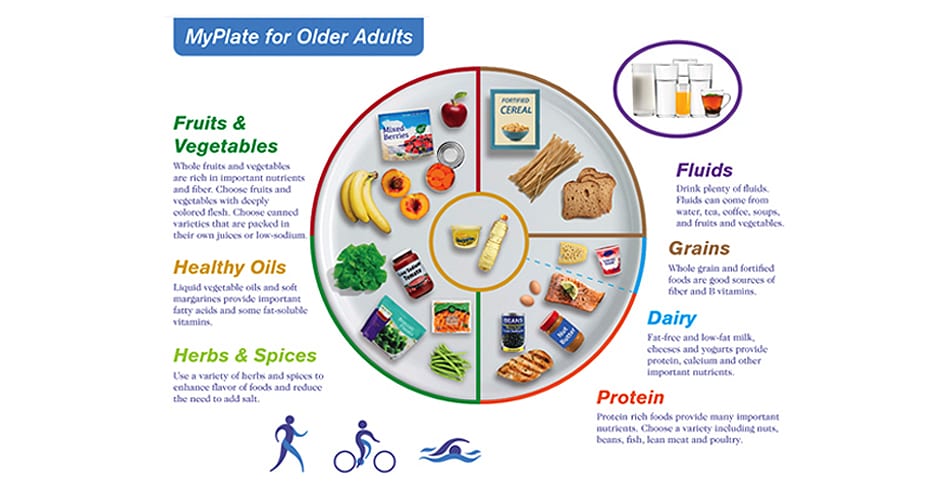
Your stage in life to a large degree shapes your dietary requirements. For seniors, the complexity of their lives is reflected in their complex nutritional needs.
An elderly person’s body has different energy requirements and nutritional needs to their younger counterparts, and the right food choices are imperative to keep health concerns such as osteoporosis, cancer and cardiovascular disease at bay. Add to this the real-life issues that food must be accessible, easy to prepare and appetising. Above all, the elderly person needs to know and remember all of this – particularly if they live at home.
Mindful of these issues, a group of Human Nutrition Research Center http://now.tufts.edu/articles/smart-food-choices-seniors on Ageing (HNRCA) scientists at Tufts University, with the support of a US charity for the aged, recently updated the American “MyPlate For Older Adults” graphic, first introduced in 1999 and now in its fourth iteration.
MyPlate for Older Adults does for seniors what words alone can’t: it provides a visual reminder of healthy eating. It helps the elderly make better food choices and benefit from a healthier and more balanced diet. MyPlate for Older Adults is based on the 2015 to 2020 Dietary Guidelines for Americans, making the advice suitable for individuals of every age. However, the colourful, easy to comprehend visual display makes the graphic particularly suitable for the elderly. See the graphic reproduced below.
According to creators of the program, now, more than ever, there is a strong need to educate senior citizens about their dietary requirements. A recent survey by AARP Foundation found that although seniors were interested in eating nutritious food as their age increased, their understanding of nutrition labels declined.
Although the program is not available in Australia, the new modifications help us to both highlight and simplify the elderly’s nutritional issues.
Most of us are familiar with the fact that the elderly require less calories per day than when they were young. When you age, your metabolism slows down; your lean muscle mass diminishes, and your energy requirements are less. Because of this, it’s all the more important for the elderly to make every bite count. MyPlate’s graphic focuses on variety, highlighting the five food groups: fruits, vegetables, grains, protein and dairy.
High nutritional levels are required for the elderly, particularly as certain nutrients such as magnesium and B12 may be difficult to absorb. According to the World Health Organisation, older people are particularly vulnerable to malnutrition. These problems are compounded by practical issues that our seniors face – a problem that was also addressed in MyPlate. These practical issues can include seniors no longer driving, which can make regular shopping for fresh food a problem. In addition, cooking a meal on one’s own can be tedious, but can also be downright difficult leading some elderly people to give up. The graphic attempts to counter these issues by suggesting quality frozen or canned vegetables or fruits, which not only last longer but can be accessed in small quantities.
Shifting the dairy focus was another of the 2016 changes. Despite the graphic having a dairy section in previous versions, cheese and yoghurt have now been incorporated into the protein section – acknowledging both as a great source of protein for the elderly. This decision was bolstered by recent studies indicating that our need for protein increases as we age.
Special mentions go to ensuring adequate fluid in the diet: tea, coffee, water, soups and even fruit and vegetables have been added to address the important issue of dehydration. Heart-healthy fats are included such as soft margarines and vegetable oils, and as sodium intake can be an issue for many seniors, the use of herbs and spices is encouraged for added flavour.
Enhancing nutrition for good immunity was of paramount concern. As we age, some parts of our immunity over-perform, resulting in inflammatory conditions such as arthritis, while other parts underperform, which can result in infection. Once unwell, an older person’s appetite can decrease, along with the body’s ability to metabolise nutrients, creating a downward spiral.
This US example shows that while nutrition for the elderly may be complex, the use of simple and user-friendly tools such as MyPlate for Older Adults can really help the elderly with healthy diet choices.
5